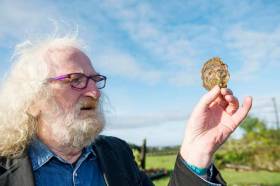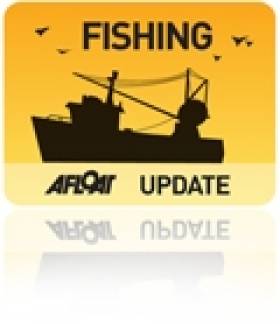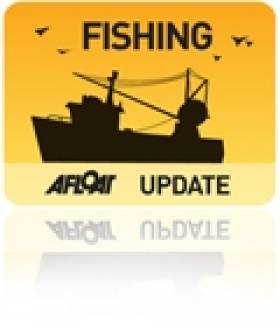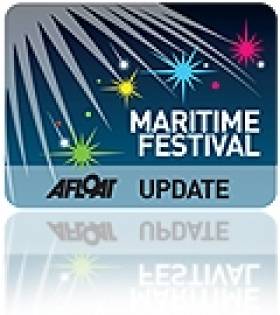Displaying items by tag: Oyster
A former Dun Laoghaire Harbour based Sailing School instructor will lead a new Oyster Yachts management team following the purchase of the luxury boat builder after it went under in February, according to British media reports.
YBW.com reports here, that Richard Hadida has purchased Oyster Yachts and all of its subsidiaries and has brought the owner of one–time Dun Laoghaire Harbour–based sailing school, Sailing West, Paul Adamson on board.
Adamson and his wife Audrey sailed around the world from 2012 to 2014 working professionally for ex Formula One Team Boss, Dubliner Eddie Jordan and prior to that ran the Sailing West Sailing School based at Dun Laoghaire's ferry terminal.
More recently, Adamson has been working as a 'motivational speaker', details as per his website here.
As Afloat.ie reported at the time, the British luxury yacht builder stopped production in February with the loss of some 380 employees at its UK sites at Southampton and Wroxham in Norfolk after the Dutch private equity firm, HTP Investments, announced it would no longer continue to financially support the company.
Hadida is now forming a management team, led by Oyster skipper Adamson, who captained Eddie Jordan's Oyster 885, LUSH in the Oyster World Rally in 2014.
Adamson was also a regular competitor on the Dublin Bay SB20 Sportsboat circuit.
Hadida, who regularly sails on LUSH, told Yachting Monthly he has used his own personal fortune to buy Oyster and all of its subsidiaries, including Oyster Palma and Oyster Newport in the USA.
"Every part of the business, including brokerage and chartering, I plan to bring back to life,' he noted. 'I am not looking to flip it, there is no exit planning, I am in it for the long run, it will be a lifetime business."
His first priority will be on the 26 customers whose Oysters were in build when the company closed its doors.
"We are hoping to start employing people as of tomorrow. At the moment, we have boats in every stage of build from the mould to almost complete and we need to get people on these boats and building them fast. I want to get those yard doors open and start building boats again," stressed Hadida.
Adamson, who will act as 'Chief Transformation Officer', added that the 26 customers with Oysters in build will get exactly what they ordered.
Native Oyster Fisheries Highlighted at Clarinbridge Festival
A Native Oyster Workshop has drawn on heritage and science to highlight the importance and future of the Native Oyster fisheries across Ireland during the Clarinbridge Oyster Festival.
Cuan Beo, a recently formed community based organization established with a mission of improving the quality of life, environment, economy and heritage around Galway Bay highlighted the need for action to restore the Native Oyster stocks across Ireland during the Native Oyster Workshop (NOW17) which was held in Clarinbridge last week Thursday 5th October 2017.
The workshop brought together Native Oyster Fishermen from the 8 remaining oyster fisheries in Ireland together with the relevant agencies responsible for their governance to develop a plan towards their restoration. The workshop heard that the native Oyster fisheries have been in decline for the past 200 years and are currently at an all-time low. Factors such as poor water quality, absence of fishery management plans, complex governance structures and overfishing have all contributed.
According to Diarmuid Kelly, Chairman of Cuan Beo, the aim of the workshop was to review the current status of the Native Oyster fisheries along the Atlantic coast of Ireland, to discuss the issues impacting on their productivity and identify a roadmap towards the effective management and restoration of Oyster Beds and to restore sustainable production output from these fisheries.
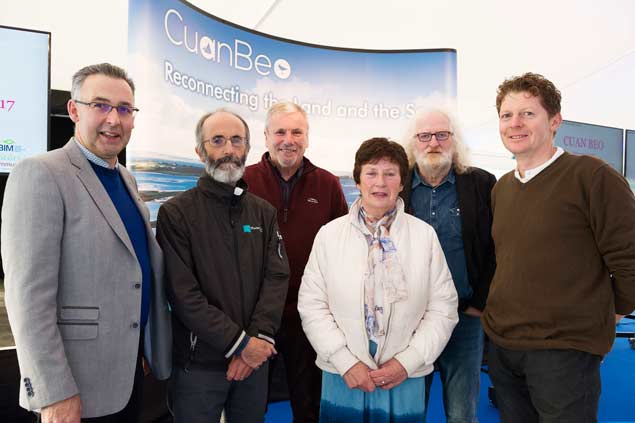 Cuan Beo committee members Diarmuid Kelly, Kelly's Oyster, Ollie Tully, Marine Institute, Seamus Breathnach BIM, Mary Gerry O'Halloran, and Colm O'Dowd Photo: Andrew Downes
Cuan Beo committee members Diarmuid Kelly, Kelly's Oyster, Ollie Tully, Marine Institute, Seamus Breathnach BIM, Mary Gerry O'Halloran, and Colm O'Dowd Photo: Andrew Downes
While Galway and Clarinbridge is synonymous with the oyster, its ecological status is poor. The situation is similar across Europe. It is listed by OSPAR as ‘threatened and declining’ and is listed as a priority habitat in the UK and in many areas in Ireland, including Galway Bay. The native oyster is subject to conservation objectives and is seen as a significant component species in Special Areas of Conservation (SACs). The workshop heard that much of the legislation is complex, misinterpreted and misunderstood.
Prof Noel Wilkins (NUI Galway) presented on the history of the native oyster beds in Galway Bay from times of super-abundance and tracking their decline to the present day. This was coupled with presentations from government agencies including the Marine Institute, the SFPA, Waters and Communities and BIM highlighting challenges relating to their restoration including licensing and governance, disease, water quality, fisheries management and displacement by invasive species. Case studies from successful fisheries were presented from Lough’s Agency in NI and Tralee Co-op.
An action plan was agreed at the workshop to create a national working group in the coming weeks. The group would not just lobby for simplification in governance but also to address assessment and up-skilling of existing co/op management in each area and the provision of support and assistance in developing management plans for each fishery. BIM agreed to coordinate the establishment of this working group.
The day-long event concluded with the official launch of Cuan Beo, by Cllr Eileen Mannion Caothairlaoch of County Galway. The launch was also attended by Seán Kyne TD Minister of State at the Department of Rural and Community Development and the Department of Communications, Climate Action and Environment with responsibility for Natural Resources, Community Affairs, and Digital Development. Niall Sabongi (KLAW Restaurant Dublin) held a masterclass in oyster tasting with a selection of native oysters from the various fisheries across Ireland and the event was concluded with a lecture highlighting the importance of the oyster in Galway Bay from pre-historic times (4000BC) to the present day by Local Archaeologist and historian, Michael Gibbons.
The New Oyster Super Yachts 565 & 595
In 2011 Oyster announced the Oyster 885 following extensive research and development of the project to build the Oyster 100 and 125. Observing that the LY2/3 code requirements meant the Oyster 100 had only 5 cabins for the owner and crew – the team took on the challenge to comply with regulations, but more efficiently!
Oyster 885 had to deliver a great deal – Superyacht equipment, levels of furnishings, bunk lengths, headroom and all of this in a hull just below the LY3 code rule length. Extensive tank-testing followed, a blade jib and roller boom configuration developed and the hull shape and appendages were refined. Recognising from this that the "6th Generation – G6" of Oyster concepts had been conceived – the company quietly went about redesigning the whole fleet.
The Oyster 825 followed, then the Oyster 745, more tank-testing and then the Oyster 118 and most recently, the Oyster 675.
Completing the 'G6' fleet, Oyster is delighted to announce the two new models – the Oyster 565 and the Oyster 595. Aimed very much at the family sailor, and skillfully combining the learning from the larger yachts, these two new yachts also include many features refined with the 101 Oyster yachts that have circumnavigated (or are in the process of circumnavigating – 31 set sail on the Oyster World Rally last weekend on the 15th January 2017). Oyster believes that no other yacht builder has the combination of experience of large numbers of yachts circumnavigating with just the owners and friends on board and more than 35 'Superyachts' built over 24 metres - the majority of whom traded up from Oyster previous 'baby-superyachts' - the Oyster 56, launched in 1998 and of which 75 were built. The Oyster 565 & 595 create the benchmark for future larger Superyachts.
Oyster Beds to Reopen On The Foyle
#oysters – Minister of State at the Department of Communications, Energy and Natural Resources, Joe McHugh T.D. and the North's Agriculture Minister Michelle O'Neill MLA, jointly welcomed the decision by the Loughs Agency to re-open two of the six main oyster fishing beds in Lough Foyle which had been closed for the last number of weeks.
Minister McHugh said: "The decision to partially re-open the beds from 15 to 19 December 2014 will create potential opportunity to catch up to an additional 25 tonnes (up to a value of €125,000). I believe that the Agency has achieved a good balance between economic opportunity for local fishermen with a dividend for the local communities and the conservation imperative".
He added "I want to emphasise that sustainability and safeguarding this natural resource in Lough Foyle are the shared responsibilities of all stakeholders, including the licensed fishermen."
Minister O'Neill said: "Whilst I appreciate the importance of Management interventions to conserve and maintain oyster stocks, I am mindful of the impact that closure of the oyster beds has had on the livelihood of local oystermen particularly in the run-up to Christmas.
"Looking to the future, I am hopeful that there will be constructive engagement between the Agency and local fishermen on a range of issues that will safeguard the future of the Native Oyster Fishery on Lough Foyle.
Ministers had jointly raised the issue of the closure of the oyster beds at the North South Ministerial Council Aquaculture and Marine Sectoral Meeting in Armagh last Friday when they asked the Agency to review its decision to close the main oyster beds.
The Ministers pointed out the need to strike a balance between the socio-economic benefits for the Foyle Oyster Fishermen and the scientific evidence to support the long term sustainability of the Native Oyster Fishery on Lough Foyle.
Both Ministers thanked the Chairman, Chief Executive and the Loughs Agency staff for efforts in reaching this decision.
Judge Convicts Men for Illegal Fishing Activities
#illegalfishing – Four men have been convicted of illegal fishing activities at two different sittings of Galway District Court on Tuesday, 1st July 2014. Judge Mary Fahy imposed fines and costs totally €4,900 to three brothers, Vidmantas Gaidys, Sigitas Gaidys and Alvydas Gaidys, convicted of illegal fishing activities; and John Costello was convicted of taking oysters illegally and fined €250, with costs of €300.
Illegal Fishing
Vidmantas Gaidys, of 21 Beal Srutha, Ballybane, Galway was convicted of using a net illegally, obstruction of fishery officers, and possession of a salmon in breach of fisheries legislation. Sigitas Gaidys, of 9C Bayview Rise, Ballybane, and Alvydas Gaidys, of Farm House, Cloonbiggen Road, Claregalway, were both convicted of the illegal use of a net, and obstruction of fishery officers.
Judge Fahy heard evidence that on the night of 19th October, 2013, the three men were in a van which fishery officers stopped close to the Clare River at Montiagh North, Claregalway, Co Galway. Vidmantas Gaidys was apprehended, while the other two men fled on foot. When the van was searched, two bags containing 78 coarse fish and 1 salmon were discovered. The other two men were later identified and interviewed. All three admitted to using a net, and pleaded guilty in court.
Judge Fahy warned that using the vehicle in the course of the offence was a serious matter, and she told Mr. Gaidys that if he came before her for a similar offence she would disqualify him from driving for two years. Vidmantas Gaidys was fined €1,500 with costs of €600, while the other two defendants were each fined €800, with €600 costs.
Illegal Oyster Fishing
At a second sitting of Galway District Court on the 1st of July, Judge Mary Fahy convicted John Costello, of Ballinacourty, Clarinbridge, Co. Galway, of taking oysters illegally from Clarinbridge Bay.
Judge Fahy heard evidence that on 5th December, 2013, Mr. Costello was observed by Fishery Officer Lonan O'Farrell hand picking oysters at Carrowmore, Ballinacourty, Co. Galway. The only legal method of harvesting wild oysters is by licensed dredge, and hand picking is strictly illegal. Mr. Costello left a bag at the shoreline, and when this was searched it was found to contain 94 wild native oysters.
Judge Fahy commented that the native oyster was under threat in many areas, and that it was very important to the local economy of the Clarinbridge area. She convicted Mr. Costello of a breach of Section 277 of the 1959 Fisheries Act, and imposed a fine of €250, with costs of €300.
Inland Fisheries Ireland (IFI) has a freefone number to enable members of the general public to report poaching incidents - 1890 34 74 24 or 1890 FISH 24. This phone line is designed to encourage the reporting of incidents of illegal fishing, water pollution and invasive species.
Galway Oyster Festival Gets Under Way
#Galway - Today 26 September marks the start of the 2013 Galway International Oyster & Seafood Festival, with a full four days of gastronomic goodness in the City of the Tribes.
Probably the most internationally recognised Irish festival after St Patrick's Day, and the world's longest running oyster festival, the weekend includes a whole host of events to enjoy, from seafood trails and oyster hot spots to the oyster shucking contests – including the Oyster 'Olympics', the World Oyster Opening Championship.
Alongside local food producer tours, some of Galway's best restaurants will hold foodie talks and tasting events, and will represent in the intimate 'food village' at the Festival Marquee.
On Saturday night, a sold-out Mardi Gras-style gala masquerade will parade through the streets of Galway.
And on Sunday, the Tribal Oyster Feast Off oyster eating competition will take place along with family activities, live music, cooking demonstrations, a 'Hot Oyster Awards' cooking challenge and more.
Established in 1954, the Galway International Oyster & Seafood Festival has welcomed over half a million visitors and consumed more than 3 million oysters – washed down with champagne and stout while listening to some of the best musicians in Ireland.
For more information on the festival, follow on Twitter @galwayoyster
Eddie Jordan's Yacht Heads off on Oyster World Rally
#oyster – Dun Laoghaire sailing school instructor Paul Adamson is on board with Eddie Jordan of Formula One fame, on the Oyster 885, Lush for the first ever Oyster World Rally.
After two years of planning, the rally started with a blast of cannon fire from Fort Charlotte, Antigua. The Georgian lookout post high above the 'Pillars of Hercules' was a perfect vantage point to watch the start of an adventure that will span a 16-month quest to sail around the world. There was tension on the dock before the start, when a vicious squall ripped through Nelson's Dockyard but undeterred, the Oyster fleet cast off lines and headed out to the starting area. Conditions at the start were nothing short of glorious; with 20 knots of warm Trade Winds and brilliant sunshine, the magnificent Oyster fleet was a spectacular sight, as they started the 27,000-mile adventure of a lifetime.
"It is such a proud moment." Enthused Oyster CEO, David Tydeman who was watching from the start line. "Today is the start of the first ever Oyster World Rally and a huge amount of effort has gone into making it happen. Watching the start was just so exhilarating but if I was being honest, I would say that I am extremely jealous; what a marvelous adventure to undertake and I am sure that the Oyster World Rally will capture the hearts and imagination of sailors the world over. It is every sailors dream to sail around the world and to witness the Oyster fleet departing today was a very special occasion for everyone associated with this event."
29 examples of the Oyster Range will take part in The Oyster World Rally. Each will have their own story to tell of the fantastic voyage. Eddie Jordan of Formula One fame, is sailing Oyster 885, Lush together with his wife, Marie. Eddie is a dab hand at the drums and gave an impromptu gig along with a sensational guitarist on the eve of the start. "It was great to wish everyone good luck last night with a bit of a dance and a sing along to a few anthems." Laughed Eddie . "This is going to be a fantastic experience, I have more air miles than you could imagine but to sail around the world is going to be the biggest adventure of them all. It is full of unknowns but that is all part of the attraction and I am just so thrilled about the whole thing."
After leaving Antigua, the Oyster World Rally heads for Panama with a rendezvous organised for all participants before entering the Panama Canal to cross into The Pacific Ocean. All of the yachts are fitted with Yellowbrick trackers throughout the 16-month Oyster World Rally.
Round the World Sailors Celebrate Cork Victory in the Caribbean
#OYSTER – A Cork yacht has taken a class win in the prestigious Oyster Regatta in the British Virgin Islands. Stephen and Aileen Hyde's Oyster 56 from Crosshaven, A Lady did not win a single race but their consistent form produced the best set of results from the Oyster Deck Saloon Division to secure victory for the Irish Team. The A Lady team is all from Ireland and they took great delight in accepting the winner's trophy and also the accolade of becoming one of the many Oysters that have circumnavigated the world's oceans. "In a single word, this regatta has been excellent." said Stephen Hyde. "I have to say that sailing 45,000 miles has been good practice for the event but winning isn't everything, there are so many good people at Oyster Regattas, I thought that the last Caribbean regatta was a great occasion and this one has certainly at least matched it. I have now sailed the world but I can say that there are few places as delightful to sail as the BVI, especially at an Oyster Regatta, it has been a memorable occasion."
Perhaps, David Tydeman, CEO of Oyster Marine summed up the Oyster's Regatta BVI at the final prize giving. "This has been one of the most friendly and enjoyable regattas of the 28 events we have had over the years. The sailing conditions have been nothing short of superb and the feedback coming from the Oyster owners is unanimous; the racecourses have provided a blend of amazing scenery and challenging sailing with close competition between the fleet. It had been especially pleasant to see nine Oysters in attendance for the first time and we hope that the experience will make them regular visitors to Oyster events."
For the last day of racing, sponsored by Pantaenius, The Oyster fleet enjoyed a passage race to Nanny Cay Marina. However, light winds necessitated a shorter course. Starting in the North Sound, a route around The Dogs then passed the western shore of Virgin Gorda, Fallen Jerusalem and Ginger Island where a finish line was laid. These islands offer mesmerising vistas of extraordinary beauty but also tactically challenging wind shifts and current eddies.
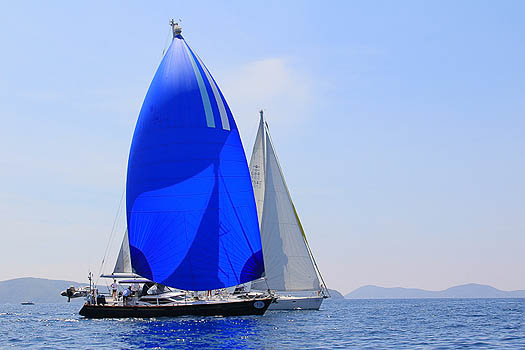
'Royal Cork's A Lady' under spinnaker and on her way to victory in the Oyster regatta yesterday
In Class 1, William Dockser's Oyster 82, Ravenous II timed the line to perfection, however this was a very competitive start especially between Chase Leavitt's Oyster 72, Holo Kai and Oyster 82, Starry Night of the Caribbean. The two powerful yachts were side by side through the line, just a few metres apart. Holo Kai managed to squeeze out Starry Night of the Caribbean and took up the early lead in the race. Chris and Susan Shea's Oyster 72, Magrathea chose to stay further to the right of the course after the start and it looked like a good choice. The graceful Oyster had better boat speed than those fighting for air in the wind shadow of The Dogs. Starry Night of the Caribbean managed to get into clear air first and powered away to win by some margin. Magrathea and Ravenous II had a tremendous battle for second place and not just for the race but also for runner up overall. Both yachts crossed the finish line together to score the same finish time. It had been a fascinating duel lasting over two hours. However, after time correction Magrathea claimed second in class with Ravenous II third.
Taking a hatrick of wins, Starry Night of the Caribbean was declared winner of Class 1, their crew boss John Burnie explained his thoughts. "It is just such a fabulous place to come for a regatta and I have to say that the courses have been excellent, hats off to Oyster, the event has really put a smile on Starry Night's crew and of course our owner, his family and guests. It is very satisfying to win but these regattas are all about enjoyment and I can safely say that we have had immense fun racing around the BVI."
In Class 1, a special mention must go to the two Oyster 655s; Michael Jones' Blue Horizons and John Noble's Neki, which came fourth and fifth respectively. Blue Horizons was competing in just their second regatta and Neki their first and both yachts scored the same number of nett points. However, Blue Horizons won the duel by virtue of a better result, (only one place!) in the last race. Also in Class 1, two Oyster 66s, Valentine and Forever Young had a tremendous battle for the line, the two yachts both had young children on board that had become friends during the regatta. Forever Young crossed the line first but Valentine won the match after time correction.
In Class 2, Ross Applebey's LW48, Scarlet Oyster was again untouchable, scoring their fourth win in a row by some distance. Ross is the youngest owner at the regatta but his team's performance showed great maturity and the extensive amount of racing experience was a big factor in their victory. "This is the first Oyster Regatta that we have competed in and I must say that the friendliness and hospitality has been fantastic." Explained Ross Applebey. "I was especially delighted that David Tydeman was on our table for the final dinner party but also the warm words of congratulation from Oyster owners has shown me the spirit of Oyster is first class. A very big thank you to everyone who has been racing and of course the Oyster team, this regatta has been a very special one for Scarlet Oyster."
Second place in the division went to Richard & Angela Parkinson's Oyster 575, Sophistikate, which finished the regatta in fine style winning the battle of the deck saloons, taking the last race of the event by over three minutes on corrected time and securing second overall, in a highly competitive class.
Three yachts had the same nett points after four races but Sopistikate was declared second by virtue of their final result. John McTigue's Oyster 56, Blue Dreams was third ahead of Bill Munro's Oyster 575, Boarding Pass III. Unfortunately the Scottish team on Boarding Pass III could not compete in the final race, a spinnaker wrap had damaged their main sail mechanism but every cloud has a silver lining, as Bill Munro explains;
"It was difficult to watch the fleet leave this morning but I was pleased to hear from Paul Bateman (Oyster 56, Stardust of Burnham) later in the day. I think that Paul showed the true spirit of Oyster when he offered me a replacement for the broken part, which he had as a spare. We meet other Oyster owners on our travels and we always try to help each other and Paul's kindness is a marvellous example of that."
On the final night of Oyster Regatta BVI, a prize giving party was held at Peg Legs Restaurant at Nanny Cay. Set right on the beach, under a carpet of stars, their was wave after wave of applause as the prize winners were announced. Oyster Owners and their crew take enormous pride in meticulously preparing and maintaining their yachts, ably assisted by the Oyster team who offer unparalleled worldwide support. Probably one of the biggest cheers of the night was for the winners of the Concours d'Elegance. Sponsored by Pelagos Yachts, Declan O'Sullivan was on hand to give out the prizes and the winners in Class 1 were Merle Gilmore's Oyster 66, Lady Tara and Michael Jones & Georgina Godolphin's Oyster 655, Blue Horizons. In Class 2, George & Sam Chandler's Oyster 56, Champlain and Richard & Angela Parkinson's Oyster 575, Sophistikate were awarded prizes for their immaculate yachts
After the prize giving ceremony, 200 guests enjoyed a sumptuous formal dinner and there were smiles all round, The Oyster family had enjoyed excellent sailing conditions, amazing scenery and a fabulous extravaganza of parties at some of the BVIs finest locations.
Owner of Oyster 72, Holo Kai, Chase Leavitt has come along way to compete, Manhattan Beach California is over 3,500 miles from the BVI. Chase summed up the spirit of the regatta.
"We have had a great time, we didn't come here to win, we came to have some fun with good friends and we definitely achieved that. I think our best manoeuvre of the week was after the finish, we anchored off Cooper Island had some cheeseburgers and went swimming, which I have got to say was a tactical masterstroke! Thank you to all the Holo Kai team. The name means seafarer in Hawaiian and comes from a place that myself and my wife Marla hold dear but we are regular visitors to the BVI, we love the atmosphere and the variety of islands so close together makes it an very interesting pace to visit."
The next Oyster Regatta will be a truly special event, hosted by the Royal Yacht Squadron from 9-14 July in Cowes to celebrate the Olympic year. Followed by t he Oyster fleet returns to Palma at the end of the summer, when many of the yachts on the Oyster World Rally will be gathering to make their way across to the Caribbean for the start of that event in Antigua on 6 January 2013.
Scottish Oyster Shucker to Compete in Galway World Championships
Son of oyster farmers Hugo and Judith Vajk of Caledonian Oysters, Angus won the Loch Fyne Scottish Oyster Opening Championships in Glasgow last month, beating a dozen other competitors including his father!
"I have been opening oysters since before I could walk," he quipped, as he accepted a prize plate from Virginia Sumsion, Marketing and Events Director of Loch Fyne Oysters. "I am thrilled to have won, and excited about going to the world championships, but it will be daunting being up against so many experts. I will be putting in a lot of speed practice this week!"
Part of his prize was a trip to Galway to enjoy the annual international oyster and seafood festival, but Angus had to wait for the organisers of the world competition to confirm that his opening time of 4 minutes 5 seconds for 30 oysters was good enough to allow him to compete there.
"Angus was a worthy winner and we are delighted to sponsor his entry in the worlds. We hope he will do well and bring the cup back home!" said Virginia Sumsion.
Seafood Scotland, which helped to organise the Scottish competition at the Glasgow Riverside Festival, also wishes Angus the very best of luck. "This is the first time ever that the world oyster opening championship has had a Scottish competitor, so it is an honour for Angus to fly the flag for his country," said Marketing Manger Clare Dixon.
Eddie Jordan Racing...On Water
Irish F1analyst Eddie Jordan might be better known for exploits on tarmac than the high seas but it did not stop the 63-year old Dubliner sailing a smart race to win in the south-eastern Caribbean Sea today in day one of the Oyster Regatta writes Louay Habib. But the F1 man's powerful Oyster 655, Lush was pushed all the way by Chris Shea's Oyster 72, Magrathea.

Eddie Jordan at the helm of the Oyster 655, Lush. Photo: Ingrid Abery
Grenada's lush, green paradise relies on rain and on the morning of Lewmar Race Day, the Oyster Fleet certainly got that. But despite the torrential downpour, the mood in Port Louis was up beat and all of the fleet left the dock, to perform a parade of sail, before heading out to the race area.
As if by magic, shortly after the start an easterly wind blew away the rain clouds. Providing dry, if somewhat tricky conditions. During the course of the day, there were numerous wind shifts, predicting these changes was the secret to success. A light airs start was followed by a building breeze, which piped up to fifteen knots by the end of the race.
Starts are always important but especially in fickle breeze and the Polish Oyster 46, SunsuSea, judged the line to perfection, to get away well. Owned by Mariusz and Paulina Kierebinscy, SunsuSea came to the Caribbean in the 2009 ARC.
"We have been really delighted with the boat." Smiled Mariusz. "My family love to sail, especially in the Caribbean. This is our second Oyster Regatta and although we have little experience with racing, it is a great way to learn how to improve our sailing technique."
Besides Mariusz and Paulina, SunsuSea is crewed by their family and friends. Daughter Claudia and son Martin are fast learners in the cockpit. Whilst friends, Artur and Margaret trim the mainsail, helped by their daughter Adriana, who is just 11 years of age.
"We really like Grenada." Continued Mariusz. 'It is such a friendly place and safe for our children. After the regatta, we will be cruising through The Grenadines to St. Lucia, our last adventure before the boat returns across the Atlantic."
In Class One, Lush, with F1 racing analyst, Eddie Jordan on board, sailed a smart race to win, but the powerful Oyster 655 was pushed all the way by Chris Shea's Oyster 72, Magrathea, who sailed a near perfect beat by using the lifting breeze, along Grande Anse Beach. Jonathon and Jane Mould's Oyster 72, Koluka claimed a well-deserved third in class.
Alan Brook, taking part in his first Oyster regatta as a competitor with his wife Sue in their Oyster 56, Sulana, won the first race in Class Two, the meticulously prepared yacht was extremely well positioned on the racecourse to win by a fair margin. Scott Bickford's American Oyster 53, Contingency was second and Ian Galbraith and crew, racing his Oyster 53, Jigsaw, kept their concentration to take third.
After the fleet had returned to the safe confines of Port Louis Marina, a cocktail party, hosted by the Marine and Yachting Association of Grenada, was full of talk about the day's events.
Later that evening, the Oyster family was treated to a lavish party at the exclusive LaLuna Estate. Tucked away south of the capital, LaLuna is the hidden gem of Morne Rouge Bay, which offers one of the finest beaches on the island, just minutes from St George's. The estate is often frequented by stars of the stage and film and provided a truly magical occasion for the second Oyster party of the regatta.
The ultra-chic secluded venue has a rustic charm extenuated by the use of traditional Caribbean materials to provide a design-fusion, which is unmistakably Asian in appearance. The wooden beachfront courtyard blends cane, cotton, and thatch and inviting day beds are scattered throughout the resort with sublime views of the perfect beach.
The Oyster family enjoyed a mouth watering four-course dinner with fine wine in a wonderful atmosphere. Afterwards, a company of dancers electrified the atmosphere and very soon the party was a very lively affair. It may have been a day of mixed fortunes on the water but the Oyster crew-conga, snaking through the LaLuna's courtyard, was testament to a very successful first day's racing at the Oyster Regatta in Grenada.
Racing resumes on Wednesday 13th April with a coastal race sponsored by Pelagos Yachts, finishing at Le Phare Bleu Marina, on the south coast of Grenada, where the fleet will overnight.





























